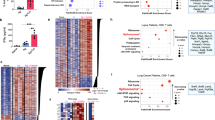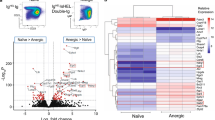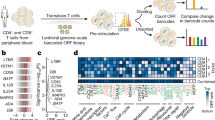Abstract
T cell receptor engagement in the absence of proper accessory signals leads to T cell anergy. E3 ligases are involved in maintaining the anergic state. However, the specific molecules responsible for the induction of anergy have yet to be elucidated. Using microarray analysis we have identified here early growth response gene 2 (Egr-2) and Egr-3 as key negative regulators of T cell activation. Overexpression of Egr2 and Egr3 was associated with an increase in the E3 ubiquitin ligase Cbl-b and inhibition of T cell activation. Conversely, T cells from Egr3−/− mice had lower expression of Cbl-b and were resistant to in vivo peptide-induced tolerance. These data support the idea that Egr-2 and Egr-3 are involved in promoting a T cell receptor–induced negative regulatory genetic program.
This is a preview of subscription content, access via your institution
Access options
Subscribe to this journal
Receive 12 print issues and online access
$209.00 per year
only $17.42 per issue
Buy this article
- Purchase on SpringerLink
- Instant access to full article PDF
Prices may be subject to local taxes which are calculated during checkout







Similar content being viewed by others
Accession codes
References
Schwartz, R.H. Costimulation of T lymphocytes: the role of CD28, CTLA-4, and B7/BB1 in interleukin-2 production and immunotherapy. Cell 71, 1065–1068 (1992).
Medzhitov, R. & Janeway, C.A., Jr. How does the immune system distinguish self from nonself? Semmin. Immunol. 12, 185–188 (2000).
Diehn, M. et al. Genomic expression programs and the integration of the CD28 costimulatory signal in T cell activation. Proc. Natl. Acad. Sci. USA 99, 11796–11801 (2002).
Riley, J.L. et al. Modulation of TCR-induced transcriptional profiles by ligation of CD28, ICOS, and CTLA-4 receptors. Proc. Natl. Acad. Sci. USA 99, 11790–11795 (2002).
Macian, F. et al. Transcriptional mechanisms underlying lymphocyte tolerance. Cell 109, 719–731 (2002).
Schwartz, R.H. A cell culture model for T lymphocyte clonal anergy. Science 248, 1349–1356 (1990).
Schwartz, R.H. T cell anergy. Annu. Rev. Immunol. 21, 305–334 (2003).
Hammerling, G.J. et al. Non-deletional mechanisms of peripheral and central tolerance: studies with transgenic mice with tissue-specific expression of a foreign MHC class I antigen. Immunol. Rev. 122, 47–67 (1991).
Staveley-O'Carroll, K. et al. Induction of antigen-specific T cell anergy: An early event in the course of tumor progression. Proc. Natl. Acad. Sci. USA 95, 1178–1183 (1998).
Heissmeyer, V. et al. Calcineurin imposes T cell unresponsiveness through targeted proteolysis of signaling proteins. Nat. Immunol. 5, 255–265 (2004).
Jeon, M.S. et al. Essential role of the E3 ubiquitin ligase Cbl-b in T cell anergy induction. Immunity 21, 167–177 (2004).
Seroogy, C.M. et al. The gene related to anergy in lymphocytes, an E3 ubiquitin ligase, is necessary for anergy induction in CD4 T cells. J. Immunol. 173, 79–85 (2004).
Kowalski, J., Drake, C., Schwartz, R.H. & Powell, J. Non-parametric, hypothesis-based analysis of microarrays for comparison of several phenotypes. Bioinformatics 20, 364–373 (2004).
O'Donovan, K.J., Tourtellotte, W.G., Millbrandt, J. & Baraban, J.M. The EGR family of transcription-regulatory factors: progress at the interface of molecular and systems neuroscience. Trends Neurosci. 22, 167–173 (1999).
Decker, E.L., Skerka, C. & Zipfel, P.F. The early growth response protein (EGR-1) regulates interleukin-2 transcription by synergistic interaction with the nuclear factor of activated T cells. J. Biol. Chem. 273, 26923–26930 (1998).
Lin, J.X. & Leonard, W.J. The immediate-early gene product Egr-1 regulates the human interleukin-2 receptor β-chain promoter through noncanonical Egr and Sp1 binding sites. Mol. Cell. Biol. 17, 3714–3722 (1997).
Mittelstadt, P.R. & Ashwell, J.D. Cyclosporin A-sensitive transcription factor Egr-3 regulates Fas ligand expression. Mol. Cell. Biol. 18, 3744–3751 (1998).
Mittelstadt, P.R. & Ashwell, J.D. Role of Egr-2 in up-regulation of Fas ligand in normal T cells and aberrant double-negative lpr and gld T cells. J. Biol. Chem. 274, 3222–3227 (1999).
Kirberg, J. et al. Thymic selection of CD8+ single positive cells with a class II major histocompatibility complex-restricted receptor. J. Exp. Med. 180, 25–34 (1994).
Huang, C.T. et al. CD4+ T cells pass through an effector phase during the process of in vivo tolerance induction. J. Immunol. 170, 3945–3953 (2003).
Warner, L.E., Svaren, J., Milbrandt, J. & Lupski, J.R. Functional consequences of mutations in the early growth response 2 gene (EGR2) correlate with severity of human myelinopathies. Hum. Mol. Genet. 8, 1245–1251 (1999).
Turman, J.E., Jr., Chopiuk, N.B. & Shuler, C.F. The Krox-20 null mutation differentially affects the development of masticatory muscles. Dev. Neurosci. 23, 113–121 (2001).
Pape, K.A. et al. Use of adoptive transfer of T-cell-antigen-receptor-transgenic T cell for the study of T-cell activation in vivo. Immunol. Rev. 156, 67–78 (1997).
Perez, V.L. et al. Induction of peripheral T cell tolerance in vivo requires CTLA-4 engagement. Immunity 6, 411–417 (1997).
Glynne, R. et al. How self-tolerance and the immunosuppressive drug FK506 prevent B-cell mitogenesis. Nature 403, 672–676 (2000).
Lechner, O. et al. Fingerprints of anergic T cells. Curr. Biol. 11, 587–595 (2001).
Harris, J.E. et al. Early growth response gene-2, a zinc-finger transcription factor, is required for full induction of clonal anergy in CD4+ T cells. J. Immunol. 173, 7331–7338 (2004).
Powell, J.D., Ragheb, J.A., Kitagawa-Sakakida, S. & Schwartz, R.H. Molecular regulation of interleukin-2 expression by CD28 co-stimulation and anergy. Immunol. Rev. 165, 287–300 (1998).
Mueller, D.L. E3 ubiquitin ligases as T cell anergy factors. Nat. Immunol. 5, 883–890 (2004).
Powell, J.D., Bruniquel, D. & Schwartz, R.H. TCR engagement in the absence of cell cycle progression leads to T cell anergy independent of p27(Kip1). Eur. J. Immunol. 31, 3737–3746 (2001).
Adler, A.J., Huang, C.T., Yochum, G.S., Marsh, D.W. & Pardoll, D.M. In vivo CD4+ T cell tolerance induction versus priming is independent of the rate and number of cell divisions. J. Immunol. 164, 649–655 (2000).
Warner, L.E. et al. Mutations in the early growth response 2 (EGR2) gene are associated with hereditary myelinopathies. Nat. Genet. 18, 382–384 (1998).
Acknowledgements
We thank B. Majane (National Institutes of Health, Bethesda, Maryland) for help in breeding and maintaining the mouse lines; C. Chen and L. Luu for technical assistance; and D.M. Pardoll (Johns Hopkins University, Baltimore, Maryland) for critical review of the manuscript. Supported by the National Cancer Institute (R01CA098109-02).
Author information
Authors and Affiliations
Corresponding author
Ethics declarations
Competing interests
The authors declare no competing financial interests.
Supplementary information
Supplementary Fig. 1
Potential anergic networks. (PDF 593 kb)
Rights and permissions
About this article
Cite this article
Safford, M., Collins, S., Lutz, M. et al. Egr-2 and Egr-3 are negative regulators of T cell activation. Nat Immunol 6, 472–480 (2005). https://doi.org/10.1038/ni1193
Received:
Accepted:
Published:
Issue Date:
DOI: https://doi.org/10.1038/ni1193
This article is cited by
-
PD-1 blockade-unresponsive human tumor-infiltrating CD8+ T cells are marked by loss of CD28 expression and rescued by IL-15
Cellular & Molecular Immunology (2021)
-
EGR2 is elevated and positively regulates inflammatory IFNγ production in lupus CD4+ T cells
BMC Immunology (2020)
-
Detecting qualitative changes in biological systems
Scientific Reports (2020)
-
Loss of EGR3 is an independent risk factor for metastatic progression in prostate cancer
Oncogene (2020)
-
Age-related decrease in muscle satellite cells is accompanied with diminished expression of early growth response 3 in mice
Molecular Biology Reports (2020)



